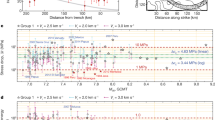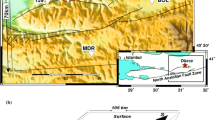Abstract
Evidence supporting a smooth crack-like rupture process of the Michoacan earthquake of 1985 is obtained from a major earthquake for the first time. Digital strong motion data from three stations (Caleta de Campos, La Villita, and La Union), recording near-field radiation from the fault, show unusually simple ramped displacements and permanent offsets previously only seen in theoretical models. The recording of low frequency (0 to 1 Hz) near-field waves together with the apparently smooth rupture favors a crack-like model to a step or Haskell-type dislocation model under the constraint of the slip distribution obtained by previous studies. A crack-like rupture, characterized by an approximated dynamic slip function and systematic decrease in slip duration away from the point of rupture nucleation, produces the best fit to the simple ramped displacements observed. Spatially varying rupture duration controls several important aspects of the synthetic seismograms, including the variation in displacement rise times between components of motion observed at Caleta de Campos. Ground motion observed at Caleta de Campos can be explained remarkably well with a smoothly propagating crack model. However, data from La Villita and La Union suggest a more complex rupture process than the simple crack-like model for the south-eastern portion of the fault.
Similar content being viewed by others
References
Aki, K. (1968),Seismic Displacement Near a Fault, J. Geophys. Res.73, 1359–1376.
Aki, K., andRichards, P. G. Quantitative Seismology: Theory and Methods (W. H. Freeman, San Francisco 1980).
Anderson, J. G., Bodin, P., Brune, J. N., Prince, J., Singh, S. K., Quaas, R., andOnate, M. (1986),Strong Ground Motion from the Michoacan Mexico Earthquake, Science233, 1043–1049.
Archuleta, R. (1984),A Faulting Model for the 1979 Imperial Valley Earthquake, J. Geophys. Res.89, 4559–4585.
Archuleta, R., andHartzell, S. (1981),Effect of Fault Finiteness on Near-source Ground Motion, Bull. Seismol. Soc. Am.71, 939–957.
Astiz, L., Kanamori, H., andEissler, H. (1987),Source Characteristics of Earthquakes in the Michoacan Seismic Gap in Mexico, Bull. Seismol. Soc. Am.77, 1326–1346.
Beroza, G., andSpudich, P. (1988),Linearized Inversion for Fault Rupture Behavior: Application to the 1984 Morgan Hill, California Earthquake, J. Geophys. Res.93, 6275–6296.
Bodin, P. andKlinger, T. (1986),Coastal Uplift and Mortality of Intertidal Organisms Caused by the September 1985 Mexico Earthquake, Science233, 1071–1073.
Bouchon, M. (1978),A Dynamic Source Model for the San Fernando Earthquake, Bull. Seismol. Soc. Am.68, 1555–1575.
Bouchon, M. (1979),A Discrete Wavenumber Representation of Elastic Wave Fields in Three-space Dimensions, J. Geophys. Res.84, 3609–3614.
Brune, J. (1970),Tectonic Stress and the Spectra of Seismic Shear Waves from Earthquakes, J. Geophys. Res.75, 4997–5009.
Burridge, R., andKnopoff, L. (1964),Body Force Equivalents for Seismic Dislocations, Bull. Seismol. Soc. Am.64, 1874–1888.
Burridge, R., andWillis, J. R. (1969),The Self-similar Problem of the Expanding Elliptical Crack in an Anisotropic Solid, Proc. Cambridge Phil. Soc.66, 443–468.
Campillo, M., Gariel, J. C., Aki, K., andSánchez-Sesma, F. J. (1989),Destructive Strong Ground Motion in Mexico City: Source, Path, and Site Effects during the Great 1985 Michoacan Earthquake, Bull. Seismol. Soc. Am.79, 1718–1735.
Das, S., andAki, K. (1970),Fault Planes with Barriers: A Versatile Earthquake Model, J. Geophys. Res.82, 5648–5670.
Das, S., andKostrov, B. V. (1985),An Elliptical Asperity in Shear-fracture Process and Seismic Radiation, Geophys. J. R. Astron, Soc.80, 725–742.
Day, S. (1982),Three-dimensional Finite Difference Simulation of Fault Dynamics: Rectangular Faults with Fixed Rupture Velocity, Bull. Seismol. Soc. Am.72, 703–727.
Ekström, G., andDziewonski, A. M. (1986),A Very Broad-band Analysis of the Michoacan Mexico Earthquake of September 19, 1985, Geophys. Res. Lett.13, 605–608.
Haskell, N. A. (1968),Elastic Displacements in the Near-field of Propagating Fault, Bull. Seismol. Soc. Am.59, 865–908.
Iwan, W. D., Moser, M. A., andPeng, C.-Y. (1985),Some Observations on Strong-motion Earthquake Measurements using a Digital Accelerograph, Bull. Seismol. Soc. Am.75, 1225–1246.
Kostrov, B. V. (1964),Self-similar Problems of Propagation of Shear Cracks, J. Appl. Math. Mech. (Engl. Trans.)28, 1077–1087.
Madariaga, R. (1976),Dynamics of an Expanding Circular Fault, Bull. Seismol. Soc. Am.66, 639–666.
Madariaga, R. (1977),High Frequency Radiation from Crack (Stress Drop) Models of Earthquake Faulting, Geophys. J. R. Astron. Soc.51, 625–651.
Mansinha, L., andSmylie, D. E. (1971),The Displacement Field of Inclined Faults, Bull. Seismol. Soc. Am.61, 1433–1440.
Mendoza, C., andHartzell, S. (1989),Slip Distribution of the 19 September 1985 Michoacan, Mexico, Earthquake: Near-source and Teleseismic Constraints, Bull Seismol. Soc. Am.79, 655–669.
Mendoza, C., andAnderson, J. G. (1991),The Temporal and Spatial Evolution of the 19 September 1985 Michoacan Earthquake as Inferred from Near-source Ground-motion Records Bull. Seismol. Soc. Am.81, 844–861.
Mikumo, T., andMiyatake, T. (1978),Dynamical Rupture Process on a Three-dimensional Fault with Non-uniform Frictions and Near-field Seismic Waves, Geophys. J. R. Astron. Soc.54, 417–438.
Olson, A., Orcutt, J., andFrazier, G. (1984),The Discrete Wavenumber/Finite Element Method of Synthetic Seismograms, Geophys. J. R. Astron. Soc.77, 421–460.
Priestley, K., andMasters, T. G. (1986),Source Mechanism of the September 19, 1985 Michoacan Earthquake and its Implication, Geophys. Res. Lett.13, 601–604.
Sato, T., andHirasawa, T. (1973),Body Wave Spectra from Propagating Shear Cracks, J. Phys. Earth21, 415–431.
Singh, S. K., andSaurez, G. (1988),Regional Variations in the Number of Aftershocks of Large Subduction Zone Earthquakes, Bull. Seismol. Soc. Am.78, 230–242.
Spudich, P., (1980),The de Hoop-Knopoff Representation Theorem as a Linear Inverse Problem, Geophys. Res. Lett.7, 717–720.
Stolte, C., McNally, K. C., andGonzalez-Ruiz, J. (1986),Fine Structure of a Post-failure Wadati-Benioff Zone, Geophys. Res. Lett.13, 577–580.
UNAM-Seimology-Group (1986),The September 1985 Michoacan, Earthquake: Afreshock Distribution and Histoory of Rupture, Geophys. Res. Lett.13, 573–576.
Yomogida, K. (1988),Crack-like Rupture Processes Observed in Near-fault Strong Motion Data, Geophys. Res. Lett.15, 1223–1226.
Author information
Authors and Affiliations
Rights and permissions
About this article
Cite this article
Ruppert, S.D., Yomogida, K. A crack-like rupture model for the 19 September 1985 Michoacan, Mexico, earthquake. PAGEOPH 138, 407–427 (1992). https://doi.org/10.1007/BF00876880
Received:
Revised:
Accepted:
Issue Date:
DOI: https://doi.org/10.1007/BF00876880




